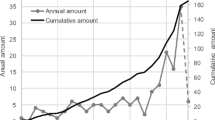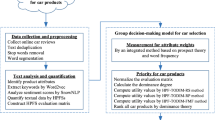Abstract
For many companies, green product development has become a key strategic consideration due to regulatory requirements and market trends. In this paper, the life cycle assessment technique is used to develop an innovative multi-criteria group decision-making approach that incorporates power aggregation operators and a TOPSIS-based QUALIFLEX method in order to solve green product design selection problems using neutrosophic linguistic information. Differences in semantics as well as the risk preferences of decision-makers are considered in the proposed method. The practicality and effectiveness of the proposed approach are then demonstrated through an illustrative example, in which the proposed method is used to select the optimum green product design, followed by sensitivity and comparative analyses.
Similar content being viewed by others
References
Atanassov KT (1986) Intuitionistic fuzzy sets. Fuzzy Sets Syst 20(1):87–96
Bao GY, Lian XL, He M, Wang LL (2010) Improved two-tuple linguistic representation model based on new linguistic evaluation scale. Control Decis 25(5):780–784
Branda M (2015) Diversification-consistent data envelopment analysis based on directional-distance measures. Omega 52:65–76
Cao LY, Li MZ, Sadiq R, Mahadevan S, Deng Y (2015) Developing environmental indices using fuzzy numbers power average (FN-PA) operator. Int J Syst Assur Eng Manag 6(2):139–149
Chan HK, Wang XJ, Raffoni A (2014) An integrated approach for green design: life-cycle, fuzzy AHP and environmental management accounting. Br Account Rev 36(4):344–360
Chan HK, Wang XJ, White GRT, Yip N (2013) An extended fuzzy-AHP approach for the evaluation of green product designs. IEEE Trans Eng Manag 60(2):327–339
Chen SJ, Hwang CL (1992) Fuzzy multiple attribute decision making: methods and applications. Springer, Berlin
Chen TY (2014) Interval-valued intuitionistic fuzzy QUALIFLEX method with a likelihood-based comparison approach for multiple criteria decision analysis. Inf Sci 261:149–169
Chen TY, Chang CH, Rachel Lu JF (2013) The extended QUALIFLEX method for multiple criteria decision analysis based on interval type-2 fuzzy sets and applications to medical decision making. Eur J Oper Res 226(3):615–625
Frei M, Züst R (1997) The eco-effective product design—the systematic inclusion of environmental aspects in defining requirements. In: Krause FL, Seliger G (eds) Life cycle networks, Springer US, pp 163–173
Herrera F, Herrera-Viedma E (2000) Linguistic decision analysis: steps for solving decision problems under linguistic information. Fuzzy Sets Syst 115(1):67–82
Herrera F, Herrera-Viedma E, Verdegay JL (1996) A model of consensus in group decision-making under linguistic assessments. Fuzzy Sets and Syst 78(1):73–87
Junnila S (2008) Life cycle management of energy-consuming products in companies using IO-LCA. Int J Life Cycle Assess 13(5):432–439
Kahneman D, Tversky A (1979) Prospect theory: an analysis of decision under risk. Econometrica 47(2):263–291
Liao HC, Xu ZS (2014) Some algorithms for group decision making with intuitionistic fuzzy preference information. Int J Uncertain Fuzziness Knowl Based Syst 22(4):505–529
Liao HC, Xu ZS (2015) Approaches to manage hesitant fuzzy linguistic information based on the cosine distance and similarity measures for HFLTSs and their application in qualitative decision making. Expert Syst Appl 42(12):5328–5336
Liao HC, Xu ZS, Zeng XJ (2015) Distance and similarity measures for hesitant fuzzy linguistic term sets and their application in multi-criteria decision making. Inf Sci 271:125–142
Liu AY, Wei FJ (2011) Research on method of analyzing the posterior weight of experts based on new evaluation scale of linguistic information. Chin J Manag Sci 19(6):149–155
Liu PD, Teng F (2015) Multiple attribute decision making method based on normal neutrosophic generalized weighted power averaging operator. Int J Mach Learn Cybern. doi:10.1007/s13042-015-0385-y
Liu PD, Yu XC (2014) 2-Dimension uncertain linguistic power generalized weighted aggregation operator and its application in multiple attribute group decision making. Knowl Based Syst 57:69–80
Ma YX, Wang JQ, Wang J, Wu XH (2016) An interval neutrosophic linguistic multi-criteria group decision-making method and its application in selecting medical treatment options. Neural Comput Appl. doi:10.1007/s00521-016-2203-1
Mansoux S, Popoff A, Millet D (2014) A simplified model to include dynamic product-user interaction in the eco-design process. J Ind Ecol 18(4):529–544
Mart L, Ruan D, Herrera F (2010) Computing with words in decision support systems: an overview on models and applications. Int J Comput Intell Syst 3(4):382–395
Ng CY, Chuah KB (2012) Evaluation of eco design alternatives by integrating AHP and TOPSIS methodology under a fuzzy environment. Int J Manag Sci Eng Manag 7(1):43–52
Paelinck JHP (1976) Qualitative multiple criteria analysis, environmental protection and multiregional development. Pap Reg Sci 36(1):59–76
Paelinck JHP (1977) Qualitative multicriteria analysis: an application to airport location. Environ Plan 9(8):883–895
Paelinck JHP (1978) Qualiflex: a flexible multiple-criteria method. Econ Lett 1(3):193–197
Peng JJ, Wang JQ, Wang J, Zhang HY, Chen XH (2016) Simplified neutrosophic sets and their applications in multi-criteria group decision-making problems. Int J Syst Sci. 47(10):2342–2358
Peng JJ, Wang JQ, Wu XH, Wang J, Chen XH (2015) Multi-valued neutrosophic sets and power aggregation operators with their applications in multi-criteria group decision-making problems. Int J Comput Intell Syst 8(2):345–363
Peng JJ, Wang J, Zhang HY, Chen XH (2014) An outranking approach for multi-criteria decision-making problems with simplified neutrosophic sets. Appl Soft Comput 25:336–346
Rivieccio U (2008) Neutrosophic logics: prospects and problems. Fuzzy Sets Syst 159(14):1860–1868
Simanovska J, Valters K, Bažbauers G, Luttropp C (2012) An ecodesign method for reducing the effects of hazardous substances in the product lifecycle. Latv J Phys Tech Sci 49(5):81–93
Smarandache F (1999) A unifying field in logics. Neutrosophy: neutrosophic probability, set and logic. American Research Press, Rehoboth
Szmidt E (2014) Distances and similarities in intuitionistic fuzzy sets. In: Kacprzyk J (ed) Studies in fuzziness and soft computing. Springer, Berlin
Tian ZP, Wang J, Zhang HY, Chen XH, Wang JQ (2015a) Simplified neutrosophic linguistic normalized weighted Bonferroni mean operator and its application to multi-criteria decision-making problems. Filomat. doi:10.2298/FIL1508576F
Tian ZP, Zhang HY, Wang J, Wang JQ, Chen XH (2015b) Multi-criteria decision-making method based on a cross-entropy with interval neutrosophic sets. Int J Syst Sci. doi:10.1080/00207721.2015.1102359
Wan SP (2013) Power average operators of trapezoidal intuitionistic fuzzy numbers and application to multi-attribute group decision making. Appl Math Model 37(6):4112–4126
Wang XJ, Chan HK (2013) An integrated fuzzy approach for evaluating remanufacturing alternatives of a product design. J Remanuf 3(1):1–19
Wang XJ, Chan HK, White L (2014) A comprehensive decision support model for the evaluation of eco-designs. J Oper Res Soc 65(6):917–934
Wang JQ, Wang DD, Zhang HY, Chen XH (2014a) Multi-criteria outranking approach with hesitant fuzzy sets. OR Spectr 36(4):1001–1019
Wang JQ, Wu JT, Wang J, Zhang HY, Chen XH (2014b) Interval-valued hesitant fuzzy linguistic sets and their applications in multi-criteria decision-making problems. Inf Sci 288:55–72
Wang J, Wang JQ, Zhang HY, Chen XH (2015a) Multi-criteria decision-making based on hesitant fuzzy linguistic term sets: an outranking approach. Knowl Based Syst 86:224–236
Wang JC, Tsao CY, Chen TY (2015b) A likelihood-based QUALIFLEX method with interval type-2 fuzzy sets for multiple criteria decision analysis. Soft Comput 19(8):2225–2243
Wang JQ, Wu JT, Wang J, Zhang HY, Chen XH (2015c) Multi-criteria decision-making methods based on the Hausdorff distance of hesitant fuzzy linguistic numbers. Soft Comput. 20(4):1621–1633
Wang XJ, Chan HK, Lee CKM, Li D (2015d) A hierarchical model for eco-design of consumer electronic products. Technol Econ Dev Econ 21(1):48–64
Wang XJ, Chan HK, Li D (2015e) A case study of an integrated fuzzy methodology for green product development. Eur J Oper Res 241(1):212–223
Xian SD, Sun WJ (2014) Fuzzy linguistic induced Euclidean OWA distance operator and its application in group linguistic decision making. Int J Intell Syst 29(5):478–491
Xu ZS (2006) A note on linguistic hybrid arithmetic averaging operator in multiple attribute decision-making with linguistic information. Group Decis Negot 15(6):593–604
Xu ZS (2008) Group decision making based on multiple types of linguistic preference relations. Inf Sci 178(2):452–467
Xu ZS, Chen J (2008) An overview of distance and similarity measures of intuitionistic fuzzy sets. Int J Uncertain Fuzziness Knowl Based Syst 16(4):529–555
Xu ZS, Xia MM (2011) Distance and similarity measures for hesitant fuzzy sets. Inf Sci 181:2128–2138
Yager RR (2001) The power average operator. IEEE Trans Syst Man Cybern Part A Syst Hum 31(6):724–731
Yang CM, Liu TH, Kao CH, Wang HT (2010) Integrating AHP and DELPHI methods to construct a green product assessment hierarchy for early stage of product design and development. Int J Oper Res 7(3):35–43
Yao JS, Wu KM (2000) Ranking fuzzy numbers based on decomposition principle and signed distance. Fuzzy Sets Syst 116(2):275–288
Ye J (2014) A multicriteria decision-making method using aggregation operators for simplified neutrosophic sets. J Intell Fuzzy Syst 26(5):2459–2466
Ye J (2015) An extended TOPSIS method for multiple attribute group decision making based on single valued neutrosophic linguistic numbers. J Intell Fuzzy Syst 28(1):247–255
Zadeh LA (1965) Fuzzy sets. Inf Control 8(3):338–353
Zeng SZ (2013) Some intuitionistic fuzzy weighted distance measures and their application to group decision making. Group Decis Negot 22(2):281–298
Zhang HY, Ji P, Wang J, Chen XH (2015) An improved weighted correlation coefficient based on integrated weight for interval neutrosophic sets and its application in multi-criteria decision-making problems. Int J Comput Intell Syst 8(6):1027–1043
Zhang HY, Wang J, Chen XH (2016) An outranking approach for multi-criteria decision-making problems with interval-valued neutrosophic sets. Neural Comput Appl. 27(3):615–627
Zhang XL, Xu ZS (2015) Hesitant fuzzy QUALIFLEX approach with a signed distance-based comparison method for multiple criteria decision analysis. Expert Syst Appl 42(2):873–884
Zhang ZM, Wu C (2014) A novel method for single-valued neutrosophic multi-criteria decision making with incomplete weight information. Neutrosoph Sets Syst 4:35–49
Zhou H, Wang J, Zhang HY, Chen XH (2016) Linguistic hesitant fuzzy multi-criteria decision-making method based on evidential reasoning. Int J Syst Sci 47(2):314–327
Acknowledgments
The authors would like to thank the editors and anonymous reviewers for their helpful comments and suggestions. This work was supported by the National Natural Science Foundation of China (Nos. 71271218, 71571193 and 71431006).
Author information
Authors and Affiliations
Corresponding author
Rights and permissions
About this article
Cite this article
Tian, Zp., Wang, J., Wang, Jq. et al. Simplified Neutrosophic Linguistic Multi-criteria Group Decision-Making Approach to Green Product Development. Group Decis Negot 26, 597–627 (2017). https://doi.org/10.1007/s10726-016-9479-5
Published:
Issue Date:
DOI: https://doi.org/10.1007/s10726-016-9479-5




